Flight log
Pre-Flight Ground Inspection on a Cessna 172
Before taking a plane to the sky, the pilot must careful inspect it. This inspection is the first of many checklist that exist to improve safety. In this page and video I explain how I do the pre-flight check on the Scout's Cessna 172. The purpose of the ground inspection is to verify the integrity of the airframe, to ensure that engine oil and fuel are at the right levels and free of contaminants, and to check the functionality of the basic engine components and flight controls.

My pre-flight inspection.
The ground pre-flight check on the Cessna 172 is a critical step to ensure the aircraft is in a safe and operational condition before every flight. This systematic procedure involves examining various parts of the airplane to check for any signs of damage or irregularities that could compromise safety or performance. From verifying the integrity of the airframe and ensuring all fluids are at the right levels to checking the functionality of the engine and controls, every item is scrutinized.
Starting with the exterior, pilots inspect the fuselage, wings, and control surfaces for any structural damage, ensuring that all surfaces are free of cracks or corrosion. They'll look over the fuel quantity and quality, checking for any contamination. The landing gear is not overlooked, ensuring it's secure and the tires are adequately inflated. On the inside, the cockpit is reviewed for any loose items that could interfere with the controls and all instruments and avionics are checked for proper operation.
The engine requires special attention; oil levels are checked, and cowling fasteners are inspected to ensure nothing is loose or missing. The propeller and spinner are checked for nicks, cracks, or any signs of wear. Finally, pilots run through a series of checks for the flight controls' freedom of movement and proper operation, ensuring everything moves smoothly and correctly.
This pre-flight check acts as the last line of defense against potential issues, aiming to catch any problems on the ground before they become serious in the air. By meticulously reviewing each component, pilots can confidently take to the skies, knowing their aircraft is as safe and prepared as possible.
My pre-flight check process
Here's how I do the pre-flight inspection.
Starting at the Front
The inspection begins at the front of the plane, focusing on the propeller. It's vital to check for any chips or damage and ensure the propeller edges are intact. A peek inside the engine reveals a rubber belt that should have proper tension without visible damage. It's also essential to clear out any debris that could have accumulated, like bird nests or other objects.
Front wheel
Next, I usually check the hydraulic dampener by applying weight to the propeller. This is to ensure the front landing gear wheel and hydraulic dampener are functioning correctly.
The fuselage
Moving along the side of the plane, I press against the panels to ensure they are secure. The static vent, critical for the altimeter, must be unblocked. Air intakes and vents, such as the cabin air intake, need to be clear for proper airflow. I also examine the wing lead, stall horn, and pitot tube, crucial for the aircraft's aerodynamics and instrumentation.
Wings, wheels and fuel
The wings demand attention, particularly the strut and tank vents. It's important to monitor the tire pressure and brake pads for signs of wear or hydraulic leaks. A thorough check includes ensuring the ailerons and flaps are moving freely and that all hinges and control surfaces are intact and unobstructed. I also verify the aircraft's balance by inspecting the baggage compartment and ensuring nothing heavy alters the plane's equilibrium.
Final Checks
The rear of the plane, including the horizontal stabilizer and elevators, needs to be free-moving and in good condition. The rudder's movement is tested along with the tension of its wires. After ensuring the undercarriage is damage-free, I proceed to check the engine oil and fuel levels, using a dipstick for the oil and a marked stick for the fuel. Finally, a critical step is to test for fuel contamination, using a cup to sample fuel from various points and checking for water or other impurities.
Lights and flaps
Before concluding the pre-flight check, I activate the electrical system to test the flaps and lights. This includes the strobe, navigation, taxi, and landing lights. Ensuring these components function correctly is vital for visibility and control during the flight.
Wrapping Up
The pre-flight ground inspection is a detailed process that takes around ten minutes but is crucial for safety and performance. It involves a systematic approach to examining every part of the Cessna 172, from the propeller to the tail, ensuring everything is in optimal condition before takeoff. This routine is not just about following a checklist; it's about understanding and ensuring the aircraft's integrity for a safe flight. With everything checked and rechecked, the plane is ready to soar.
Don't miss the next flight log
Leave your email address by clicking on the button below, and I'll let you know as soon as I publish my next flight log. No spam, ever.
The propeller should be clear of any damage.
The taxi (left) and landing (right) lights are working.
One of the ventilation air intakes. All air intakes should be clear of debris and obstructions.
The ailerons should move freely and in opposite directions.
A detail of the undercarriage. Check for possible tailstrike.
Checking the oil quantity.
Checking the fuel quantity.
Looking for contamination in this fuel sample.
Ensure this static vent is clear of obstructions.